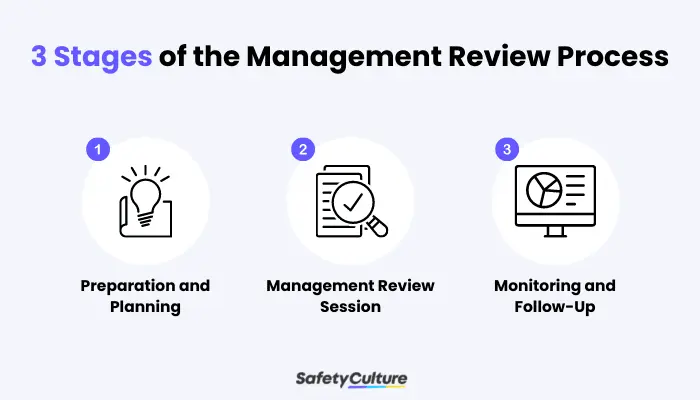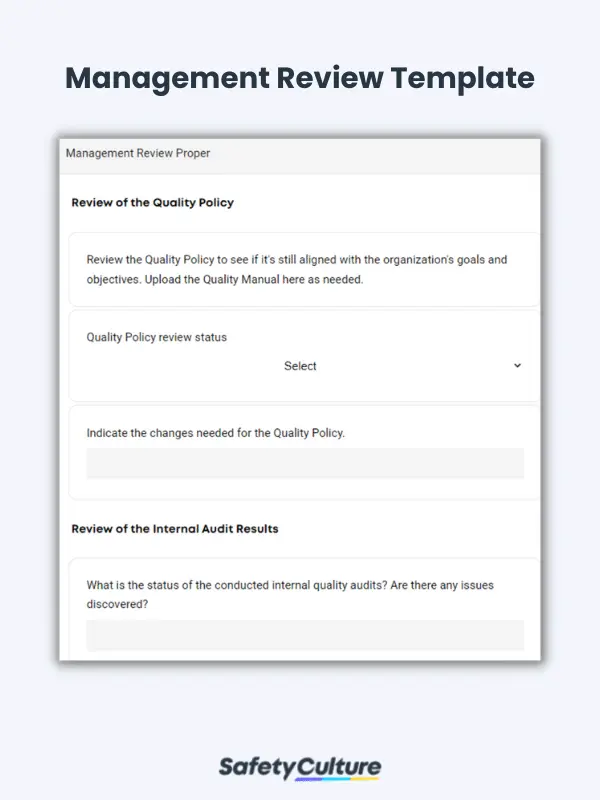What is a Management Review?
A management review is a regular evaluation of the performance of management systems based on their purpose and goal, as well as whether they are producing desirable results aligned with the organization’s needs. Often, an organization’s top management conducts management reviews to continuously improve processes and standards toward proactively addressing concerns and issues.
Importance of Management Review
While management review meetings aren’t part of the requirements of running a management system certified by the International Organization for Standardization (ISO), companies’ top management teams still have to conduct management reviews. This is because they are an essential component of completing and following the compliance requirements in the management system performance evaluation set out by the certification standard.
Commonly, a management review is used to assess an organization’s Quality Management System (QMS). This is in preparation for when a company or business applies for and maintains compliance with an ISO certification, specifically the QMS standard called ISO 9001. In fact, Clause 9 of the ISO 9001 standard outlines the requirements for a management review, especially its necessary inputs and outputs.
Apart from the quality management review, other management systems that also require conducting management reviews are the following:
- ISO 45001 – Occupational Health and Safety Management System (OHSMS)
- ISO 14001 – Environmental Management System (EMS)
- ISO 27001 – Information Security Management System (ISMS)
It’s also worth noting that management reviews play a significant role in an organization’s collective efforts toward continuous improvement. Reviewing the standards and guidelines set out in the management system helps leaders and point persons address areas to be corrected or improved so they can be aligned with the organization’s goals and objectives.
Management Review Inputs and Outputs
A management review, being part of the requirements of an ISO-certified management system, has specific inputs and outputs that must be taken into account by the top management. The inputs are key elements in such a way that these serve as the basis for the review to be conducted. The outputs, on the other hand, are the items or steps to be taken as a follow-up from the management review.
In detail, the following are the specific inputs and outputs of a management review:
What are the inputs of management review?
- Results of past management audits (e.g., internal audits)
- Relevant customer feedback
- Process performance
- Corrective and Preventive Action (CAPA) progress
- Follow-up from previous management reviews
- Changes that have a direct impact on the management system (e.g., incident statistics and review of recent accident investigations, environmental impact and aspects, and relevant legislative changes)
- Improvement recommendations from internal audit results
What are the outputs of management review?
- Action items for improving the management system
- Product improvement steps to address customer requirements
- Resource needs
- Opportunities for investments and expansion
- Employee development programs
A Practical Guide to the Process

Management Review Process | SafetyCulture
Conducting management reviews can become time-consuming and seemingly complicated. Without an established process and guidelines to help make it practical, the results may fail to satisfy the management system’s goals and objectives.
That said, it’s crucial to understand and implement the overall management review procedure, which involves 3 critical stages:
1. Preparation and Planning
Establish a clear agenda for the review to be conducted. It’s also best to set out a feasible schedule and make sure to let everyone required to attend the meeting know the specifics of the review.
Preparation is key in ensuring that such reviews are going to be practical and well-thought-out. During the first stage, gather insights and data that represent actual results of how your organization’s management systems are performing. Depending on the format that’ll best demonstrate and summarize such data, collect reports from respective departments or point persons to prepare for presentation during the review meeting. These can then serve as guiding documents for discussion and evaluation.
Some guide questions to ask while collating insights and data include the following:
- What is the status of the conducted internal audits? Are there any risks and opportunities discovered?
- Any progress on our CAPAs?
- Are the current suppliers we have continuously supported the organization during the past 6 months?
2. Management Review Session
As a requirement of an ISO-certified management system, the discussions, evaluations, and results from management reviews must be well-documented. This is where the management review outputs come into play. The most common ones include the minutes of the review meeting, the recommended next steps, and key resource needs to carry out the goals and objectives of the improvement plan.
The plan must now include the following and more, depending on the discussion:
- Clear details of what needs to be done
- Defined roles and responsibilities of people in charge
- Feasible timelines and schedules to accomplish the next steps and plan the necessary follow-ups
- Outlined resources and other requirements
- Established metrics and processes for evaluating results
Create Your Own Management Review Template
Eliminate manual tasks and streamline your operations.
Get started for FREEUsing a management review template also helps guide the management team and other leaders on how to conduct a management review meeting. The template form can make the process of documenting the minutes of the review meeting more efficient while recording the discussion points and analysis results during the review proper. To help you better visualize what it looks like, here’s an example that you can use in SafetyCulture (formerly iAuditor):
3. Monitoring and Follow-Up
Reviewing the performance of management systems doesn’t stop at documenting the required inputs and outputs. It’s also important to set up a process of monitoring, reporting, and following up on the status and progress of the action plan.
As a management best practice, make sure to establish a culture of accountability and ownership so that each aspect of the improvement actions needing to be implemented are continuously being worked on and monitored. With this, having Objective Key Results (OKRs) in place can help in objectively measuring the success of every action item. Lastly, ensure that there’s an agreed-upon schedule of the succeeding reviews and/or follow-up review meetings to be conducted.
Create a Better Organization with Management Systems Training
Given the prior discussion, there’s no question about how management reviews are valuable to you and how they can help you create a better organization. However, because of the many aspects of management reviews, it can be difficult to identify how to train your managers to become great reviewers or auditors. One of the best ways to do this starts with management systems training.
Luckily, Training has some management systems training courses lined up for you. The courses available in Training’s course library tackle a variety of topics, such as how different management systems work and some internal auditing techniques they can replicate. Enrich these courses with custom interactive elements like videos, quizzes, and gamified assessments that will encourage your team to stick around from start to finish.
FAQs About Management Review
Internal audits are often conducted by qualified or certified internal auditors with the purpose of assessing if the organization’s current processes and practices are aligned with the fulfillment of the ISO standard’s requirements. Management reviews, on the other hand, are held by the top management to gauge how well the management system is performing based on the desired results of the objectives.
Both offer the chance for organizations to explore the performance of their current management systems, pinpoint areas for improvement, and proactively address issues for continuous improvement.
An organization’s systems and processes are required to be reviewed by top management, including business leaders, and quality managers. Hence, they must be present during the regularly conducted reviews. Also, depending on the type of management system being reviewed, other members of the organization can attend to align the objectives and goals better.
As part of an organization’s efforts toward continuous improvement, being able to evaluate and enhance the way its management systems work should be a regular component of the business’s overall strategies. Hence, management reviews are encouraged to be conducted at planned intervals: quarterly, bi-annually, or annually.
A management review meeting (MRM) is a formal session with the main purpose of discussing and recording the evaluation results of reviewing an organization’s management system. Even if it isn’t required in earning an ISO certification from a third party, an MRM is a key component of helping top management teams efficiently document the inputs and outputs from the review.




